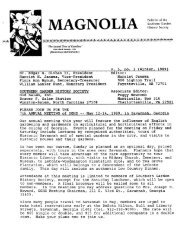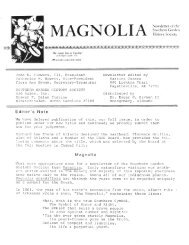Vol. XII, no. 2, 3 & 4 - Southern Garden History Society
Vol. XII, no. 2, 3 & 4 - Southern Garden History Society
Vol. XII, no. 2, 3 & 4 - Southern Garden History Society
Create successful ePaper yourself
Turn your PDF publications into a flip-book with our unique Google optimized e-Paper software.
<strong>Southern</strong> <strong>Garden</strong>s of th e<br />
1850s . . . continued from page 3<br />
desirable .<br />
The Spruces are the most prized of this family i n<br />
Europe, although so common, that they are planted by<br />
the thousand to serve as screens to lawns and gardens ,<br />
and to plantations of other less hardy trees . The<br />
Norway Spruce, (Abies excelsa) (sic) 11 the mos t<br />
common, is also the most beautiful . In fact, I k<strong>no</strong>w o f<br />
<strong>no</strong> tree that equals it in gorgeous and impressive<br />
beauty. Some ten years ago, I imported a lot of fin e<br />
plants of this and other Spruces ; and, as in every othe r<br />
attempt to import young evergreens either from th e<br />
North or Europe, I saved but a very small percentage .<br />
Of those saved were two Norway Spruces . For five<br />
years they did <strong>no</strong>t make a growth of more than an inc h<br />
a year! After that they shot up rapidly, and are <strong>no</strong>w<br />
beautiful, healthy plants, eight or ten feet in height .<br />
Since then I have been more successful in<br />
young plants to the climate, and have fine<br />
The only<br />
extan t<br />
landscape<br />
design fo r<br />
Henry<br />
Watson ,<br />
1857, i n<br />
Greensboro,<br />
Alabama .<br />
habituating<br />
young tree s<br />
of severa l<br />
species o f<br />
Spruce .<br />
The<br />
Cedars<br />
are very<br />
beautiful .<br />
And, b y<br />
the way ,<br />
what w e<br />
k<strong>no</strong>w a s<br />
the Red<br />
Cedar, i s<br />
a Juniper ,<br />
hearing a<br />
smal l<br />
purpl e<br />
berry; the<br />
Cedars<br />
are cone -<br />
bearing . Cedrus deodara, the Great Indian Cedar is th e<br />
most splendid tree of this family; perfectly hardy here ,<br />
and of very rapid growth; rare, however . The Cedars of<br />
Leba<strong>no</strong>n is also hardy, but of much slower growth .<br />
Two new evergreen Conifers, Cryptomeria<br />
Japonica and Cunninghamii (sic) Sinensis - the former<br />
from japan, the latter from China - I look upon as great<br />
acquisitions. Both are at home in our climate ; requiring,<br />
however, like all of these resi<strong>no</strong>us evergreens, a ligh t<br />
sandy, but rich soil; and are most graceful and beautiful ,<br />
yet curious ornaments to the lawn or door-yard .<br />
A<strong>no</strong>ther of these, the great Chili Pine, (Arancaria<br />
imbricata), has <strong>no</strong>t succeeded so well ; though I have <strong>no</strong>w a<br />
few young seedlings that seem to feel themselves at home .<br />
The Junipers, headed by our own native ,<br />
the so-called Red Cedar, (J. virginiana) are<br />
indispensable. In the "Red Cedar" there is a grea t<br />
diversity of foliage and habit of growth ; som e<br />
being open and loose in habit, others uprigh t<br />
and compact . The latter I have always selected from<br />
the seed-bed . They should have room to grow, and b e<br />
allowed to sweep the ground with their branches ; <strong>no</strong>t<br />
pruned up into the likeness of a gigantic broom !<br />
The Swedish Juniper 12 is very upright in growt h<br />
and with fine and delicate, silvery foliage, an d<br />
altogether a pretty plant .<br />
The Arbo Vita is well k<strong>no</strong>wn - that is, the Chinese ,<br />
(orientalis), the sort common here . And to form a pretty<br />
screen hedge, I k<strong>no</strong>w of <strong>no</strong>thing more beautiful :<br />
requiring to be kept nicely clipped, and the seed cone s<br />
picked off so soon as large e<strong>no</strong>ugh - otherwise th e<br />
foliage becomes brown .<br />
The American Arbor Vitae, (Thuja occidentalis,) i s<br />
still a more desirable plant ; bearing the shears equall y<br />
well, retaining its color better, and the foliage givin g<br />
out a sweet odor when crushed . The Thuja plicata is a<br />
wavy-foliaged, pendulous kind, also pretty .<br />
It was long before I succeeded with the Yews .<br />
The English Yew is <strong>no</strong>w perfectly healthy and grow s<br />
vigorously. Its close, dark green foliage renders it ver y<br />
desirable, and especially in the cemetery, where fro m<br />
time immemorial. it has been considered the most<br />
fitting ornament .<br />
And so with the Tree Boxes - the neatest and prettiest<br />
of evergreen trees ; always fresh and pleasant to<br />
look on. They grow better here than even their nativ e<br />
climate; as does, also, the Dwarf Box, for edgings .<br />
The Euonymus, evergreen and variegated, ar e<br />
both very ornamental . The evergreen is often misname d<br />
Tree Box. They are very hardy and grow rapidly .<br />
There are several of the Viburnum which are<br />
handsome evergreens . V. Lucidum (sic) 13 has rich dark<br />
foliage and showy white flowers, and makes a larg e<br />
plant . V. laurus-tinus (sic) 14 , or Laurustinus is one of<br />
the very richest of our flowering evergreens ; blooming ,<br />
too, so very early in the spring, or in the winter rather ,<br />
as to be very desirable .<br />
The Laurels are all beautiful. But, like many of our<br />
finest plants - because <strong>no</strong>t named in Northern book s<br />
on gardening; and because Downing expresses his<br />
regret, at the same time that he gives expression to hi s<br />
admiration of the plants, that they are "too aristocrati c<br />
in their nature to thrive on , our Republican!" 15 - the<br />
whole tribe has been overlooked . The Laurus <strong>no</strong>bilis ,<br />
the Portugal, the English, and the Carolinian laurels l 6<br />
are perfectly hardy - the three first after habituation<br />
to the climate - and are rich and very beautifu l<br />
evergreens . I have splendid plants of all, and especiall y<br />
of the English - (Cerasus lauro-cerasus .)<br />
continued on page 8 . . .<br />
4
















